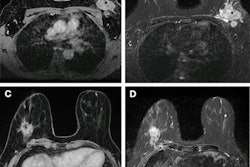Making relatively minor changes in the breast MRI workflow and facility design can help to increase patient throughput, a research group from Radboud University Medical Center in Nijmegen reported at the recent European Society of Breast Imaging (EUSOBI) annual meeting.
"Reducing MRI scanning time by implementing an abbreviated MRI protocol and reducing MRI room occupation by the use of multiple changing rooms and dockable tables resulted in shorter appointment duration and increased availability of the MRI scanner," noted first author Lejla Koco, a doctoral candidate in the radiology department at Radboud University Medical Center (RUMC) in Nijmegen, the Netherlands.
Cost and availability are important factors preventing wider MRI application in breast cancer screening, Koco and her colleagues explained. This prompted them to create a model of an optimal scanning environment for breast MRI screening. Their study findings presented at EUSOBI 2023 aimed to provide insight into the extent to which the logistics of breast MRI can be optimized, the key goal being to improve workflow.
"Restructuring workflow, layout, and resources in breast MRI screening can boost throughput by 91%," they pointed out.
At the RUMC, different MRI protocols are used for breast imaging with MRI, depending on the purpose. Staff use a 20-minute MRI protocol for diagnostic imaging and an eight-minute abbreviated MRI (abMRI) protocol for screening. The motivation to implement abMRI is to increase cost-effectiveness.
"The idea is to be able to scan more women within the same timeframe with MRI," Koco explained. "This would therefore allow greater access to MRI screening for more women and reduce the time women have to spend inside the MRI scanner (anxiety, claustrophobia, lying still)."
With the abbreviated MRI protocol, three patients can be scanned per hour, and if diffusion-weighted imaging is omitted, it is also possible to scan four patients in one hour. Another important benefit is that the MRI scanner is almost continuously in use, she added.
Real-life data
The team's study involved developing a novel concept for a breast MRI screening facility.
They collected real-life logistic data from 62 breast MRI screening exams conducted at three different hospitals. The data were imported using 3D simulation software (FlexSim Healthcare). The group then designed and tested a series of different scenarios composed of combinations of different layouts, staff composition, scanning protocols, equipment (e.g., dockable vs. nondockable tables), and number of changing rooms.
"Screening within these modeled facilities was simulated for a time span of three months, with opening hours from 8:00 to 18:00 and variations in patient arrival patterns," Koco and colleagues noted. "The model provided several realistic, virtual, logistical pathways for MRI screening, and their outcome measures like patient throughput and waiting times."
The baseline scenario, simulated using the existing workflow steps and recourses, had a total average appointment time of 25 minutes and 54 seconds, of which the MRI room was occupied for just over 19 minutes. On average, 36 patients per day could be screened.
The group's optimum scenario was a 390 sq. m. facility layout focused on patient communication, workflow, accessibility, and accommodating dockable tables. Implementing a suitable patient arrival pattern, using an abMRI, and implementing other changes resulted in an average appointment time of 19 minutes and 36 seconds, of which the MRI room was occupied for 6 minutes and 21 seconds.
"Having three radiographers and four changing rooms (with dockable tables) seemed to be most efficient approach, leading to a throughput of around 67 patients per day," they stated. "Perfusion-only scanning protocol reduces table time from 12 minutes and 49 seconds to 5 minutes and 42 seconds."
Moving pre- and post-processing outside the MRI boosts workflow. "Using abMRI scanning protocols alone isn't enough to improve throughput significantly because bottlenecks like changing room and dockable table availability may still exist."
Future research should assess workflow, protocol efficiency, cost-effectiveness, and the potential business case for optimized screening facility construction, they concluded.
You can read the full EUSOBI e-poster here. Koco's fellow authors in this study were Luuk Balkenende (Netherlands Cancer Institute, Amsterdam), Aljoscha Sponsel (Siemens), Markus Schimanski (Siemens), Linda Appelman (Alexander Monro Hospital, Eindhoven), Mathias Prokop (RUMC), and Ritse Mann (RUMC and Netherlands Cancer Institute).



















